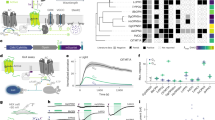Abstract
THE receptor in the carotid body for changes in blood gas tensions has for many years been assumed to be the glomus cell1,2 or Type I cell3. Lever, Lewis and Boyd4 showed by electron microscopy that the nerve endings adjacent to these cells contain microvesicles, of the same dimension as synaptic vesicles, and small mitochondria, and this observation was confirmed by Biscoe and Stehbens5,6, who described the structure of the endings in greater detail and showed that they are similar to those of an efferent type in other parts of the nervous system7 and share a dense junctional region with the Type I cell membrane. Biscoe and Stehbens8 later found that the endings degenerated after the carotid sinus nerve was cut, and it seemed probable, in accordance with the evidence of De Castro1,2, that they were afferent nerve endings. It is also possible, however, that such endings arise from efferent nerve fibres coursing in the carotid sinus nerve to the carotid body. The purpose of the present experiments was to seek evidence for such efferent fibres.
This is a preview of subscription content, access via your institution
Access options
Subscribe to this journal
Receive 51 print issues and online access
$199.00 per year
only $3.90 per issue
Buy this article
- Purchase on Springer Link
- Instant access to full article PDF
Prices may be subject to local taxes which are calculated during checkout
Similar content being viewed by others
References
De Castro, F., Trab. Lab. Invest. Biol. Univ. Madr., 24, 365 (1926).
De Castro, F., Trab. Lab. Invest. Biol. Univ. Madr., 25, 331 (1927).
De Kock, L. L., Acta Anat., 21, 101 (1954).
Lever, J. D., Lewis, P. R., and Boyd, J. D., J. Anat., 93, 478 (1959).
Biscoe, T. J., and Stehbens, W. E., Nature, 208, 708 (1965).
Biscoe, T. J., and Stehbens, W. E., J. Cell Biol., 30, 563 (1966).
Gray, E. G., and Guillery, R. W., Intern. Rev. Cytol., 19, 111 (1966).
Biscoe, T. J., and Stehbens, W. E., Quart. J. Exp. Physiol., 52, 31 (1967).
Biscoe, T. J., Sampson, S. R., and Purves, M. J., Nature, 215, 654 (1967).
Biscoe, T. J., and Silver, A., J. Physiol., 183, 501 (1966).
Author information
Authors and Affiliations
Rights and permissions
About this article
Cite this article
BISCOE, T., SAMPSON, S. Spontaneous Activity recorded from the Central Cut End of the Carotid Sinus Nerve of the Cat. Nature 216, 294–295 (1967). https://doi.org/10.1038/216294a0
Received:
Issue Date:
DOI: https://doi.org/10.1038/216294a0
Comments
By submitting a comment you agree to abide by our Terms and Community Guidelines. If you find something abusive or that does not comply with our terms or guidelines please flag it as inappropriate.



